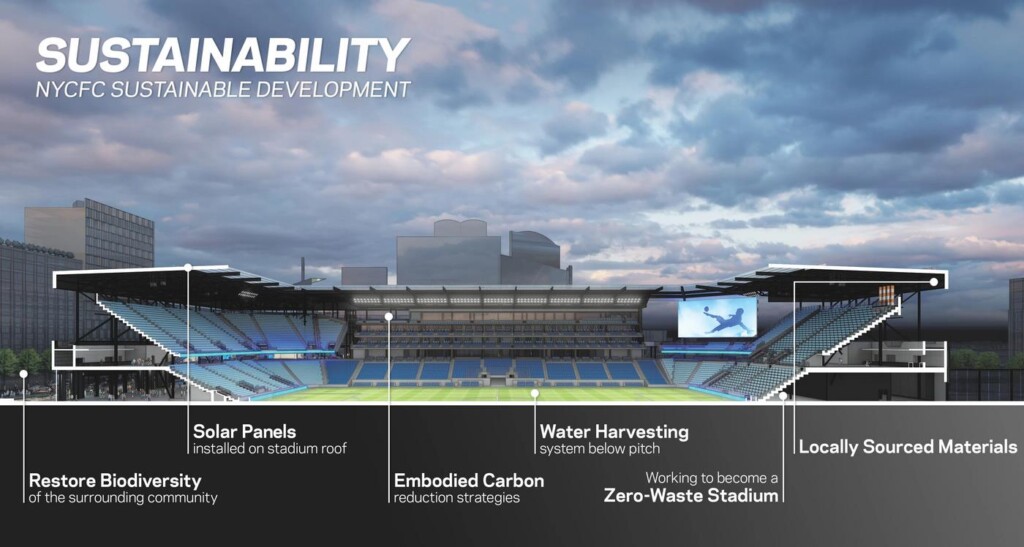
New York City Football Club (NYCFC) recently revealed their proposal for a new soccer stadium in Willets Point, Queens, that would be totally electric, partly run on green energy, and built with recycled materials that conserve water and reduce waste.
Sports stadiums are pretty unsustainable places, whether that’s the large amount of water needed for the toilets and field irrigation, the massive concrete parking lots, stadium stands, and roofs that soak up heat, or the fact that all concessions are single-serving plastics and papers.
Addressing sustainability from top to bottom, from the beginning of match day to the time when the janitors leave, is really what the Willets Point project is all about.
The 25,000-seat stadium would become the first fully electric stadium in Major League Soccer, (MLS) in addition to being the first fully electric professional sports stadium in New York City.
The stadium and development plans have entered the Uniform Land Use Review Process this week, and the club will be hoping to receive permission to break ground as soon as possible because there is a lot of work to be done.
In addition to a fully electric stadium which will be privately financed, the Willets Point development project would also deliver a total of 2,500 units of 100% affordable housing at the site, as well as a 650-seat public school, 40,000 square feet of new public open space, retail space and a 250-key hotel.
“This soccer stadium, and the larger Willets Point project, will transform a part of Queens that has a long and difficult history of environmental degradation,” said Council Member Francisco Moya.
The stadium will be all-electric, with an array of solar panels installed on the stadium roof to maximize energy generation. Built-in efficiency will ensure that intelligent systems eliminate energy waste, and a backup generator will be there for emergencies.
A water harvesting system below the stadium field will capture rainwater and reuse this for irrigation. Water efficient systems, including dry urinals, proximity-controlled taps, and reduced water mix taps and shower heads will help to reduce unnecessary consumption.

Materials, fixtures, and fittings for the stadium will wherever possible be locally sourced to avoid substantial transportation impact on the environment. Furthermore, the Club is focused on construction that will promote efficient insulation and natural venting.
SUSTAINABLE MEGAPROJECTS: Berlin’s Derelict Airport Undergoes Transformation to Become a Sustainable Neighborhood
To reduce environmental impact, the Willets Point Stadium project is committed to delivering effective means to reach the stadium through public transportation. NYCFC is building on its relationship with the Metro Transit Authority that started nearly a decade ago to continue to ensure accessible and affordable public transport options.
The Club is committed to reducing all waste at source. Fans will have easy access to drinking water refills throughout the stadium. The stadium will explore options for on-site composting of waste for local benefit.
MORE STORIES LIKE THIS: Paris Olympics Gets 11,000 Stadium Seats Made of Recycled City Plastic
Through the stadium project, the Club will work proactively with suppliers to ensure that there is a supply chain approach to its sustainability agenda, often working with small, local suppliers to improve and uplift their own related sustainability agendas, therefore improving the local community further.
“I’m proud that New York City will be home to the first fully electric sports stadium in Major League Soccer,” said Mayor Adams, a sentiment shared by the Club’s president Bret Sims, who added that “we’re focused on ensuring that the Club is leading the way when it comes to reducing environmental impact.”
SHARE This Sustainable Sports Story With Soccer Supporters You Know…




















